List of the oldest buildings in the world
This article lists the oldest free-standing buildings constructed in the world, including on each of the continents and within each country. "Building" is defined as any human-made structure used or intended for supporting or sheltering any use or continuous occupancy. In order to qualify for list a structure must:
- be a recognisable building;
- incorporate features of building work from the claimed date to at least 1.5 metres (4.9 ft) in height;
- be largely complete or include building work to this height for most of its perimeter.
- contains an enclosed area with at least one entry point.
This consciously excludes ruins of limited height and statues. The list also excludes:
- dolmens—a type of single-chamber megalithic tomb, usually consisting of three or more upright stones supporting a large flat horizontal capstone—unless they were originally covered over to form a barrow and used for collective burials. (Neolithic dolmens are extremely numerous, with over 1,000 reported from Mecklenburg-Vorpommern in Germany alone.)[1]
- cairns which are simply large piles of loose stones (as opposed to chambered cairns.)
Dates for many of the oldest structures have been arrived at by radiocarbon dating and should be considered approximate.
By age
The following are amongst the oldest buildings in the world that have maintained the requirements to be such. Occupation sites with older human made structures such as those in Göbekli Tepe do exist, but the structures are monuments and do not meet the definition of building (which can be seen above). Many of the buildings within the list contain primarily bricks, but most importantly maintain their walls and roof. There are numerous extant structures that survive in the Orkney islands of Scotland, some of the best known of which are part of the Heart of Neolithic Orkney World Heritage Site.[2] The list also contains many large buildings from the Egyptian Age of the Pyramids.
| Building | Image | Country | Continent | First Built | Use | Notes |
|---|---|---|---|---|---|---|
| Barnenez | 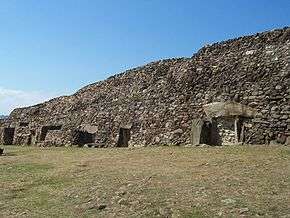 |
France | Europe | 4850 BC | Passage grave | Located in northern Finistère and partially restored. According to André Malraux it would have been better named ‘The Prehistoric Parthenon’. The structure is 72 m long, 25 m wide and over 8 m high.[3][4]
As of current, it is the oldest building by strict definition. |
| Tumulus of Bougon |  |
France | Europe | 4700 BC | Tumulus | A complex of tombs with varying dates near Poitiers, the oldest being F0.[3] |
| Tumulus Saint-Michel | .jpg) |
France | Europe | 4500 BC | Tumulus | The tumulus forms what is almost an artificial hillock of more than 30,000m3 (125m long, 60m wide and 10m high).[5][6] |
| Monte d'Accoddi |  |
Italy | Europe | 4000–3650 BC [7][8] | Possibly an open-air temple, ziggurat, or a step pyramid, mastaba. | A trapezoidal platform on an artificial mound, reached by a sloped causeway. New radiocarbon dating (2011) allow us to date the building of the first monument to 4000–3650 BC, the second shrine dating to 3500–3000 BC."[9] |
| Knap of Howar |  |
Scotland | Europe | 3700 BC | House | Oldest preserved stone house in north west Europe.[10][11][12] |
| Ġgantija |  |
Malta | Europe | 3700 BC | Temple | Two structures on the island of Gozo. The second was built four centuries after the oldest.[13][14] |
| West Kennet Long Barrow |  |
England | Europe | 3650 BC | Tomb | Located near Silbury Hill and Avebury stone circle.[15] |
| Listoghil | 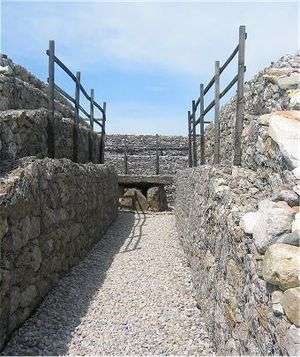 |
Ireland | Europe | 3550 BC | Passage Tomb | At the centre of the Carrowmore passage tomb cluster, a simple box-shaped chamber is surrounded by a kerb c.34m in diameter and partly covered by a cairn. It has been partly reconstructed.[16] |
| Pentre Ifan |  |
Wales | Europe | 3500 BC | Neolithic Dolmen | It contains and gives its name to the largest and best preserved neolithic dolmen in Wales. One of the oldest and best preserved Neolithic dolmen in UK. |
| Sechin Bajo | |
Peru | South America | 3500 BC | Plaza | The oldest known building in the Americas.[17] |
| La Hougue Bie |  |
Jersey | Europe | 3500 BC | Passage grave | An 18.6 metre long passage chamber. The chapel above is medieval.[18] |
| Midhowe Chambered Cairn |  |
Scotland | Europe | 3500 BC | Tomb | A well-preserved example of the Orkney-Cromarty type on the island of Rousay.[19] |
| Gavrinis passage tomb | 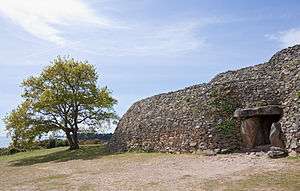 |
France | Europe | 3500 BC | Tomb | On a small island, situated in the Gulf of Morbihan.[20] |
| Wayland's Smithy |  |
England | Europe | 3460 BC | Chamber tomb | A barrow constructed on top of an older burial chamber.[21] |
| Unstan Chambered Cairn |  |
Scotland | Europe | 3450 BC | Tomb | Excavated in 1884, when grave goods were found, giving their name to Unstan ware.[22][23][24] |
| Knowe of Yarso chambered cairn |  |
Scotland | Europe | 3350 BC | Tomb | One of several Rousay tombs. It contained numerous deer skeletons when excavated in the 1930s.[22][25][26] |
| Quanterness chambered cairn |  |
Scotland | Europe | 3250 BC | Tomb | The remains of 157 individuals were found inside when excavated in the 1970s.[22][27] |
| Tarxien Temples | |
Malta | Europe | 3250 BC | Temples | Part of the Megalithic Temples of Malta World Heritage Site.[13][28] |
| Shahr-e Sukhteh | |
Iran | Asia | 3200 BC | Settlement | a rich source of information regarding the emergence of complex societies and contacts between them in the third millennium [29] |
| Skara Brae |  |
Scotland | Europe | 3180 BC | Settlement | Northern Europe's best preserved Neolithic village.[30] |
| Tomb of the Eagles |  |
Scotland | Europe | 3150 BC | Tomb | In use for 800 years or more. Numerous bird bones were found here, predominantly white-tailed sea eagle.[31][32] |
| Newgrange | |
Ireland | Europe | 3100–2900 BC | Burial | Partially reconstructed around original passage grave.[33] |
| Dolmen de Bagneux | 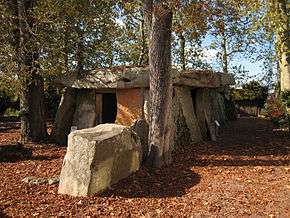 |
France | Europe | 3000 BC | Dolmen | This is the largest dolmen in France, and perhaps the world, the overall length of the dolmen is 23 m (75 ft), with the internal chamber at over 18 m (60 ft) in length and at least 3m high.[34][35][36] |
| Grey Cairns of Camster |  |
Scotland | Europe | 3000 BC or older | Tomb | Located near Upper Camster in Caithness.[37][38] |
| Hulbjerg Jættestue |  |
Denmark | Europe | 3000 BC | Passage grave | The grave is concealed by a round barrow on the southern tip of the island of Langeland. One of the skulls found there showed traces of the world's earliest dentistry work.[39][40][41] |
| Maikop kurgans | Russia | Europe | 3000 BC | Tomb | There are numerous tombs, some perhaps originating in the Maikop culture, in the North Caucasus.[42][43] | |
| Taversoe Tuick chambered cairn |  |
Scotland | Europe | 3000 BC | Tomb | Unusually, there is an upper and lower chamber.[44] |
| Holm of Papa chambered cairn |  |
Scotland | Europe | 3000 BC | Tomb | The central chamber is over 20 metres long.[45][46] |
| Barpa Langass |  |
Scotland | Europe | 3000 BC | Tomb | The best preserved chambered cairn in the Hebrides.[47][48] |
| Cuween Hill Chambered Cairn |  |
Scotland | Europe | 3000 BC | Tomb | Excavated in 1901, when it was found to contain the bones of men, dogs and oxen.[49][50] |
| Quoyness cairn |  |
Scotland | Europe | 2900 BC | Tomb | An arc of Bronze Age mounds surrounds this cairn on the island of Sanday.[51] |
| Maeshowe | 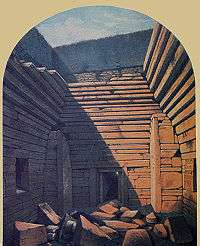 |
Scotland | Europe | 2800 BC | Tomb | The entrance passage is 36 feet (11 m) long and leads to the central chamber measuring about 15 feet (4.6 m) on each side.[52][53] |
| Pyramid of Djoser | 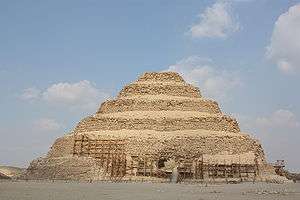 |
Egypt | Africa | 2667–2648 BC | Burial | Earliest large-scale cut stone construction.[54] |
| Harappa |  |
Pakistan | Asia | 2600BC | Settlement | A Bronze Age fortified city with clay sculpured houses in west of Sahiwal.[55]
The civilization, with a possible writing system, urban centers, and diversified social and economic system. |
| Mohenjo Daro |  |
Pakistan | Asia | 2600BC | Settlement | Archeological site near Lankana,Sindh.[56]
World's earliest settlement with one and two storied brick houses, public baths, assembly halls, central marketplace and covered drains. |
| Dholavira | |
India | Asia | 2650 BC-2100 BC | Settlement | A complex of ruins with varying dates at Dholavira.[57][58][59]
Brick water reservoirs, with steps, circular graves & ruins of well planned town. |
| Caral | |
Peru | South America | 2600 BC | Pyramid | Once thought to be the oldest building in South America.[60] |
| Pyramid of Meidum |  |
Egypt | Africa | c. 2580 BC | Tomb | Fourth Dynasty structure completed by Sneferu. |
| Bent Pyramid |  |
Egypt | Africa | c. 2580 BC | Tomb | A second structure completed by Sneferu. |
| Red Pyramid | .jpg) |
Egypt | Africa | c. 2580 BC | Tomb | Third large pyramid completed by Sneferu.[61] |
| Great Pyramid of Giza |  |
Egypt | Africa | 2560 BC | Tomb | Mausoleum for fourth dynasty Egyptian Pharaoh Khufu.[62] World's tallest man-made structure for over 3800 years, until c.1300. |
| Knowth |  |
Ireland | Europe | Between 2500-2000 BC | Passage grave | [63] |
| Pyramid of Khafre |  |
Egypt | Africa | c. 2500 BC | Tomb | One of the Pyramids of Giza.[64] |
| Pyramid of Menkaure |  |
Egypt | Africa | c. 2500 BC | Tomb | Menkaure was probably Khafre's successor. |
| Dowth |  |
Ireland | Europe | 2500 BC | Tomb | The cairn is about 85 metres (280 ft) in diameter and 15 metres (50 ft) high.[63] |
| Pyramid of Userkaf |  |
Egypt | Africa | c. 2480 BC | Tomb | Located close to Pyramid of Djoser.[65] |
| Pyramid of Sahure | |
Egypt | Africa | c. 2480 BC | Tomb | Built for Sahure.[66] |
| Pyramid of Neferirkare Kakai |  |
Egypt | Africa | c. 2460 BC | Tomb | Built for Neferirkare Kakai.[66] |
| Pyramid of Neferefre |  |
Egypt | Africa | c. 2455 BC | Tomb | Never completed but does contain a tomb.[66] |
| Pyramid of Niuserre |  |
Egypt | Africa | c. 2425 BC | Tomb | [67] |
| Pyramid of Djedkare-Isesi |  |
Egypt | Africa | c. 2370 BC | Tomb | |
| Pyramid of Unas |  |
Egypt | Africa | c. 2340 BC | Tomb | [68] |
| Pyramid of Teti |  |
Egypt | Africa | c. 2330 BC | Tomb | |
| Labbacallee |  |
Ireland | Europe | c. 2300 BC | Tomb | The largest wedge tomb in Ireland. |
| Pyramid of Merenre |  |
Egypt | Africa | c. 2275 BC | Tomb | Built for Merenre Nemtyemsaf I but not completed. |
| Pyramid of Pepi II Neferkare |  |
Egypt | Africa | c. 2180 BC | Tomb | |
| Crantit cairn | Scotland | Europe | 2130 BC | Tomb | Discovered in 1998 near Kirkwall.[69][70] | |
| Dolmen de Viera | |
Spain | Europe | 2000 BC | Tomb | The Dolmen de Viera or Dolmen de los Hermanos Viera is a dolmen—a type of single-chamber megalithic tomb[71] |
| Dolmen of Cava dei Servi | .jpg) |
Sicily | Europe | 2000 BC | Tomb | The dolmen of Cava dei Servi is a semi-oval monument formed by four rectangular slabs fixed into the ground. Three slabs are on top, leaning in such a way they reduce the surface and form a false dome.[72] |
| Rubha an Dùnain passage grave |  |
Scotland | Europe | 2000 BC or older | Tomb | [73][74][75] |
| Corrimony chambered cairn | Scotland | Europe | 2000 BC or older | Tomb | A Clava-type passage grave surrounded by a circle of 11 standing stones.[76][77] | |
| Knossos |  |
Greece | Europe | 2000–1300 BC | Palace | Minoan structure on a Neolithic site.[78] |
| Bryn Celli Ddu |  |
Wales | Europe | 2000 BC | Tomb | Located on the island of Anglesey.[79] |
| Balnuaran of Clava |  |
Scotland | Europe | 2000 BC | Tomb | The largest of three is the north-east cairn, which was partially reconstructed in the 19th century. The central cairn may have been used as a funeral pyre.[75][80][81] |
| Vinquoy cairn, Eday |  |
Scotland | Europe | 2000 BC | Tomb | [82] |
| Pyramid of Amenemhat I | 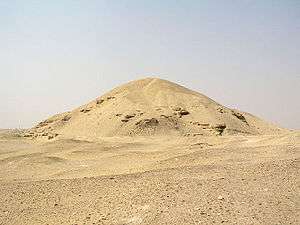 |
Egypt | Africa | c. 1960 BC | Tomb | |
| Pyramid of Senusret I |  |
Egypt | Africa | c. 1920 BC | Tomb | |
| Pyramid of Senusret II | 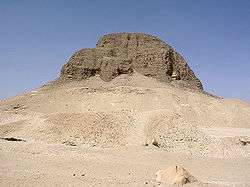 |
Egypt | Africa | c. 1875 BC | Tomb | |
| Pyramid of Senusret III | 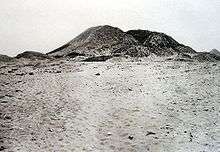 |
Egypt | Africa | c. 1835 BC | Tomb | Built for Senusret III |
| Black Pyramid |  |
Egypt | Africa | c. 1820 BC | Tomb | Built for Amenemhat III, it has multiple structural deficits. |
| Hawara | 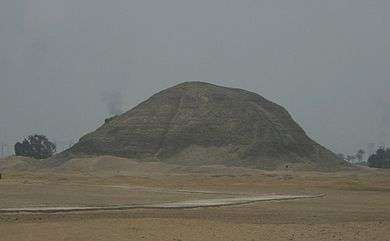 |
Egypt | Africa | c. 1810 BC | Tomb | Also built for Amenemhat III. |
| Pyramid of Khendjer | 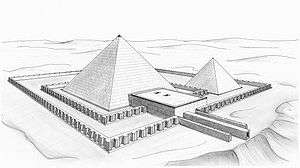 |
Egypt | Africa | c. 1760 BC | Tomb | Built for pharaoh Khendjer |
| Nuraghe Santu Antine | |
Italy | Europe | 1600 BC | Possibly a fort | The second tallest of these megalithic edifices found in Sardinia and tallest still standing.[83] |
| Su Nuraxi di Barumini | 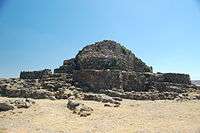 |
Italy | Europe | 1500 BC | Possibly a fort or a palace | The palace of Barumini is formed by a huge quatrefoiled nuraghe, whose central tower is its oldest construction. Originally it was almost 20 metres high and divided into three floors.[84][85] |
| Nuraghe La Prisciona | |
Italy | Europe | 1400 BC | Possibly a fort | The monument has a central tower and 2 side towers, the former with an entrance defined by a massive lintel of 3.20 m. The central chamber has a false dome, which is more than 6 meters high.[86] |
| The Ziggurat of Dur-Kurigalzu |  |
Iraq | Asia | 14th century BC | Probably religious rituals | Built for the Kassite King Kurigalzu I.[87] |
| Treasury of Atreus | 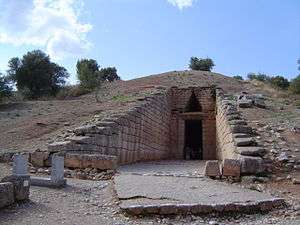 |
Greece | Europe | 1250 BC | Tomb | The tallest and widest dome in the world for over a thousand years.[88] |
| Chogha Zanbil |  |
Iran | Asia | 1250 BC | Temple | One of the few extant ziggurats outside of Mesopotamia.[89] |
| Naveta d'Es Tudons |  |
Spain | Europe | 1200-750 BC | Ossuary | The most famous megalithic chamber tomb in Minorca.[90] |
| Dún Aonghasa |  |
Ireland | Europe | 1100 BC | Fort | Dún Aonghasa, also called Dun Aengus, has been described as one of the most spectacular prehistoric monuments in western Europe. The drystone walled hillfort is made up of 4 widely spaced concentric ramparts.[91][92] |
| The King's Grave | |
Sweden | Europe | 1000 BC | Tomb | Near Kivik is the remains of an unusually grand Nordic Bronze Age double burial.[93] |
| Cuicuilco Circular Pyramid | |
Mexico | North America | 800–600 BC | Ceremonial center | One of the oldest standing structures of the Mesoamerican cultures. First steps in the creation of a sun based calendar.[94] |
| Van Fortress |  |
Turkey | Asia | 750 BC | Fortress | Massive Urartean stone fortification overlooking Tushpa. |
| Necropolises of Cerveteri and Tarquinia | 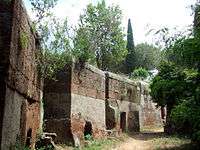 |
Italy | Europe | 700 BC | Tombs | These Etruscan necropolises contain thousands of tombs, some organized in a city-like plan.[95] |
| Temple of Hera | 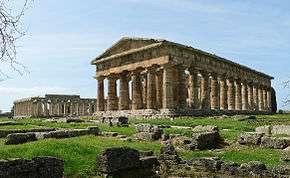 |
Italy | Europe | 550 BC | Temple | Part of a complex of three great temples in Doric style.[96] |
| Tomb of Cyrus |  |
Iran | Asia | 530 BC | Tomb | Tomb of Cyrus the Great, located in Pasargadae |
| Yeha Temple |  |
Ethiopia | Africa | 500 BC | Temple | Temple of the sun and moon. |
| Parthenon |  |
Greece | Europe | 432–447 BC | Temple | In the Acropolis of Athens |
| Sudarshan Lake | India | Asia | 319 BC | Lake | probably oldest lake of India was constructed by chandragupta maurya.It was reconstructed twice. | |
| Thracian Tomb of Kazanlak |  |
Bulgaria | Europe | 300–400 BC | Tomb | Located near Seutopolis, the capital city of the Thracian king Seuthes III, and part of a large necropolis.[97] |
| Sanchi Stupa | 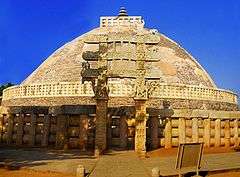 |
India | Asia | 300 BC | Buddhist temple | In the village of Sanchi |
| Dhamek Stupa | 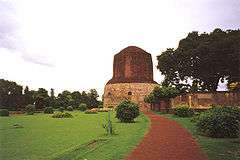 |
India | Asia | 249 BC rebuilt c500 CE | Buddhist Temple | In Sarnath, Varanasi |
| Ruwanwelisaya | Sri Lanka | Asia | 140 BC | Stupa | in Anuradhapura, Sri Lanka | |
| Broch of Mousa |  |
Scotland | Europe | 100 BC | Broch | Located in Shetland it is among the best-preserved prehistoric buildings in Europe.[98][99] |
| Dun Carloway |  |
Scotland | Europe | 100 BC | Broch | Built in the first century BCE[100] |
| Lei Cheng Uk Han Tomb Museum | 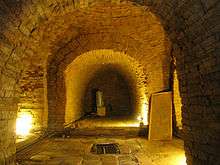 |
Hong Kong | Asia | 25 AD | Tomb | |
| Colosseum |  |
Italy | Europe | 70–80 AD | Amphitheatre |
By continent
The following are amongst the oldest extant buildings on each of the major continents.
| Building | Image | Country | Continent | First Built | Use | Notes |
|---|---|---|---|---|---|---|
| Shahr-e Sukhteh | |
Iran | Asia | 3200 BCE | Settlement | A rich source of information regarding the emergence of complex societies and contacts between them in the third millennium[29] |
| Barnenez |  |
France | Europe | 4850 BCE | Passage grave | Located in northern Finistère and partially restored. According to André Malraux it would have been better named ‘The Prehistoric Parthenon’. The structure is 72 m long, 25 m wide and over 8 m high.[3][4] |
| Sechin Bajo | |
Peru | South America | 3500 BCE | Plaza | The oldest known building in the Americas.[17][101] |
| Pyramid of Djoser |  |
Egypt | Africa | 2667–2648 BCE | Burial | Earliest large-scale cut stone construction[54] |
| Cuicuilco Circular Pyramid | |
Mexico | North America | 800–600 BCE | Ceremonial center | One of the oldest standing structures of the Mesoamerican cultures.[94] |
| Wiebbe Hayes Stone Fort | |
Australia | Australasia | 1629 CE | Defensive fort | Oldest known building in Australia, a defensive fort used by the survivors of the Batavia shipwreck on West Wallabi Island.[102] |
| Cape Adare huts | |
Ross Dependency | Antarctica | 1899 CE | Explorers' huts | Wooden buildings constructed by Carsten Borchgrevink in Victoria Land.[103] |
By country
The following are among the oldest buildings in their respective countries.
| Building | Image | Country | Continent | First Built | Use | Notes |
|---|---|---|---|---|---|---|
| Weibbe Hayes Stone Fort | .jpg) |
Australia | Australasia | 1629 AD | Stone Fort | Old stone fort built by the survivors of the Batavia shipwreck. |
| Thracian Tomb of Kazanlak |  |
Bulgaria | Europe | 300–400 BC | Tomb | Located near Seutopolis, the capital city of the Thracian king Seuthes III, and part of a large necropolis.[97] |
| Hulbjerg Jættestue |  |
Denmark | Europe | 3000 BC | Passage grave | The Hulbjerg passage grave is concealed by a round barrow on the southern tip of the island of Langeland. One of the skulls found there showed traces of the world's earliest dentistry work.[39][39] |
| West Kennet Long Barrow |  |
England | Europe | 3650 BC | Tomb | Located near Silbury Hill and Avebury stone circle.[15] |
| Barnenez |  |
France | Europe | 4850 BC | Passage grave | Located in northern Finistère and partially restored. The structure is 72 m long, 25 m wide and over 8 m high.[3][4] The oldest known building in Eurasia. |
| Porta Nigra | |
Germany | Europe | 180 AD | Roman city gate | It is today the largest Roman city gate north of the Alps.[104] |
| Dholavira | India | Asia | 2850BC | Reservoir | A planned urban settlement comprising reservoirs, pottery artifacts, seals, ornaments, vessels, etc. | |
| Chogha Zanbil |  |
Iran | Asia | 1250 BC | Temple | One of the few extant ziggurats outside of Mesopotamia.[89] |
| The Ziggurat of Dur-Kurigalzu |  |
Iraq | Asia | 14th century BC | Probably religious rituals | Built by the Kassite King Kurigalzu I.[87] |
| Newgrange | |
Ireland | Europe | 3200–2900 BC | Burial | Partially reconstructed around original passage grave.[33] |
| Monte d'Accoddi |  |
Italy | Europe | 4000–3600 BC | Possibly an open-air temple. | "A trapezoidal platform on an artificial mound, reached by a sloped causeway."[9] |
| Ġgantija | .jpg) |
Malta | Europe | 3700 BC | Temple | Two structures on the island of Gozo. The second was built four centuries after the oldest.[13][14] |
| Cuicuilco Circular Pyramid | |
Mexico | North America | 800–600 BC | Ceremonial center | One of the oldest standing structures of the Mesoamerican cultures.[94] |
| Mission House |  |
New Zealand | Australasia | 1822 | Religious | Built by Māori and missionary carpenters.[105] |
| Mehrgarh | Pakistan | Asia | c. 2600 BC | Mud brick storage structures | A complex of ruins with varying dates near Bolan Pass.[106][107] | |
| Sechin Bajo | Peru | South America | 3500 BC | Plaza | The oldest known building in the Americas.[17] | |
| Knap of Howar |  |
Scotland | Europe | 3700 BC | House | Oldest preserved stone house in north west Europe.[10][11][12] |
| Naveta d'Es Tudons |  |
Spain | Europe | 1200-750 BC | Ossuary | The most famous megalithic chamber tomb in Minorca.[90] |
| The King's Grave | |
Sweden | Europe | 1000 BC | Tomb | Near Kivik is the remains of an unusually grand Nordic Bronze Age double burial.[108] |
| Hattusa |  |
Turkey | Asia | c. 1600 BC | Ramparts and ruined buildings | Capital of the Hittite Empire in the late Bronze Age located near modern Boğazkale.[109] |
| Ancestral Puebloan communities |  |
United States | North America | 750 AD | Villages | Pueblo construction began in 750 CE and continues to the present day. These buildings have been within the U.S. since 1848, when New Mexico was annexed. |
| Bryn Celli Ddu |  |
Wales | Europe | 2000 BC | Tomb | Located on the island of Anglesey.[79] |
Miscellaneous
Oldest of their type
The following are probably the oldest buildings of their type.
| Building | Image | Location | First Built | Use | Notes |
|---|---|---|---|---|---|
| Hōryū-ji | 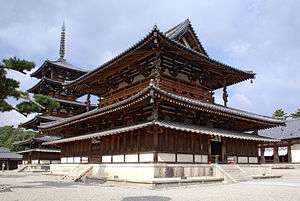 |
Nara, Japan | 670 AD | Temple | Oldest wooden building still standing.[110] |
| Pyramid of Djoser |  |
Saqqara, Egypt | 2667–2648 BC | Tomb | Oldest large-scale cut stone construction[54] |
| Göbekli Tepe |  |
Turkey | 12000–8400 BC | Ceremonial | The oldest known human-made religious structure.[111][112] |
| Jokhang | 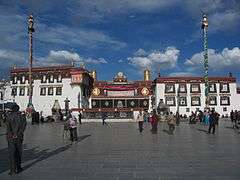 |
Lhasa, China | c. 639 AD | Buddhist temple | Perhaps the world's oldest timber frame building.[113] |
| Nanchan Temple | |
Wutai, China | 782 AD | Buddhist Temple | Its Great Buddha Hall is currently China's oldest extant timber building. |
| Ditherington Flax Mill |  |
Shrewsbury, England | 1797 AD | Industrial | The oldest iron framed building in the world.[114] |
| Maison Carrée |  |
France | 16 BC | Temple | The only completely preserved temple of the ancient world.[115] |
| Pantheon, Rome |  |
Italy | 125 AD | Religious | Oldest standing building still in regular use.[116] |
| Aula Palatina | |
Germany | 306 AD | Palace basilica | Contains the largest extant hall from antiquity.[104] |
| Greensted Church | 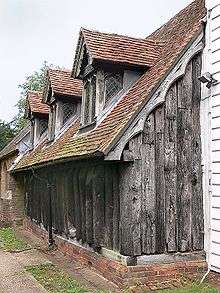 |
England | c. 1053 AD | Church | May be the oldest, extant wooden church in the world and the oldest, extant wooden building in Europe.[117][118] |
| Roykstovan in Kirkjubø | Faroe Islands | No clear date, middle of 11th century AD | Farmhouse | May be the oldest continuously inhabited wooden building in the world[119] | |
| Mundeshwari Temple | 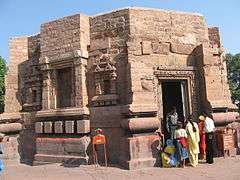 |
Bihar, India | conflicting accounts; between 105-320 AD | Hindu Temple | May be the oldest surviving (non rebuilt) Hindu temple in the world[120][121] |
Other structures
The following are very old human constructions that do not fit the above criteria for a building, typically because they are ruins that no longer fit the height requirement specified above or for which the only significant above-ground elements are single large stones.
| Building | Image | Location | First Built | Use | Notes |
|---|---|---|---|---|---|
| Theopetra cave |  |
Greece | 21000 BC | Stone wall | The oldest known human-made structure.
The structure is a stone wall that blocked two-thirds of the entrance to the Theopetra cave near Kalambaka on the north edge of the Thessalian plain. It was constructed 23,000 years ago, probably as a barrier to cold winds.[122][123] |
| Göbekli Tepe |  |
Turkey | 9500–8400 BC | Ceremonial | The oldest known human-made religious structure.[111][112] |
| Zealots of Jericho | 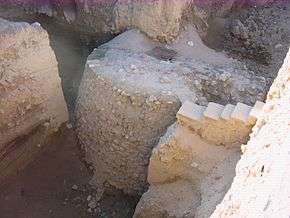 |
Palestinian territories | 8000 BC | Defensive/agricultural | See also Wall of Jericho.[124] |
| Çatalhöyük | |
Turkey | 7400–6200 BC | Village ruins | [125] |
| Khirokitia |  |
Cyprus | 5800–3000 BC | Houses | Site has reconstructions of round houses.[126] |
| Les Fouaillages | |
Guernsey | 4500 BC[127] | Tomb | Burial mound and associated building, in use from 4500-4000 and 3000-2000 BC. Findings include pottery sherds, stone tools, jewelry, flint, and arrowheads. Originally covered by a turf mound 35m long.[128] |
| Tumulus de Dissignac | 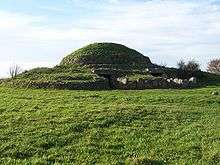 |
France | 4500–4000 BC[129] | Tumulus | Two Dolmenic chambers are covered by 15 metre diameter tumulus with corridors 11 metres in length. Substantially rebuilt.[130] |
| Table des Marchand |  |
France | 4000 BC | Dolmen | A modern cairn has been rebuilt over the capstone and supporting pillars.[131] |
| Temple of Ba`alat Gebal | _4.jpg) |
Lebanon | c. 2700 BC | Temple | Located in the Phoenician city of Byblos, the nearby Temple of the Obelisks dates to c.1900-1600 BCE.[132][133] |
| Pyramid of Sekhemkhet aka the Buried Pyramid |  |
Egypt | c. 2630 BC | Burial | An unfinished Third Dynasty structure largely hidden under sand. Only the lowest step of the pyramid was constructed at the time of his death.[134] |
| Great Sphinx of Giza | 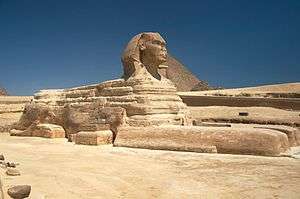 |
Egypt | 2558–2532 BC | Statue | The largest monolith statue in the world, possibly completed during the reign of Khafra, although the subject is controversial.[135][136] |
| Large Stone Structure | |
Israel | 1000 BC | Palace? | A major public building but probably not the ruins of King David's palace.[137] |
See also
Lists
- Oldest buildings in the United Kingdom
- List of the oldest buildings in the United States
- Oldest buildings in Scotland
- List of oldest church buildings
- List of the oldest mosques in the world
- Oldest synagogues in the world
Sites
- Los Millares, a Chalcolithic site in Almería, Spain including both ruins and reconstructions
References
- ↑ "Megaliths in Mecklenburg–Vorpommern". University of Toronto. Retrieved 17 July 2012.
- ↑ "Heart of Neolithic Orkney". UNESCO. Retrieved 21 July 2012.
- 1 2 3 4 Chris Scarre, Roy Switsur, Jean-Pierre Mohen (1993) "New radiocarbon dates from Bougon and the chronology of French passage-graves". Antiquity/The Free Library. Retrieved 11 September 2013.
- 1 2 3 Gibson, Marion; Trower, Shelley; Tregidga, Garry (2013) Mysticism, Myth and Celtic Identity. Routledge. Abingdon. p. 133
- ↑ "The Saint-Michel Tumulus". Culture.gouv.fr. Retrieved 11 September 2013.
- ↑ "Saint-Michel tumulus". Megalithic Portal. Retrieved 11 September 2013.
- ↑ http://arheologija.ff.uni-lj.si/documenta/pdf38/38_16.pdf
- ↑ Delfino,Carlo (ed) (2000) "The Prehistoric Altar of Monte d'Accoddi". (pdf) Archaeological Sardinia. 29. Retrieved 14 October 2013. p. 45.
- 1 2 Blake, Emma; Arthur Bernard Knapp (2004). The archaeology of Mediterranean prehistory. Wiley Blackwell. p. 117. ISBN 978-0-631-23268-1. Retrieved 31 August 2011.
- 1 2 "Knap of Howar" Historic Scotland. Retrieved 23 Sept 2011.
- 1 2 "The Knap o' Howar, Papay". Orkneyjar. Retrieved 13 July 2012.
- 1 2 Wickham-Jones, Caroline (2007) Orkney: A Historical Guide. Edinburgh. Birlinn. p. 40.
- 1 2 3 "Megalithic Temples of Malta". UNESCO. Retrieved 15 July 2012.
- 1 2 Mcintosh, Jane (2009) Handbook of Life in Prehistoric Europe. Oxford University Press. pp. 261-62Retrieved 12 August 2012.
- 1 2 "West Kennet Long Barrow, Avebury" English Heritage. Retrieved 15 July 2012.
- ↑ Alastair Whittle, Frances Healy & Alex Bayliss. Gathering time: dating the Early Neolithic enclosures of southern Britain and Ireland. 2 volumes. 2011. Oxford: Oxbow; 978-1-84217-425-8
- 1 2 3 McDonnell, Patrick J. (February 26, 2008) "A new find is the Americas' oldest known urban site". Los Angeles Times. Retrieved 12 July 2012.
- ↑ "La Hougue Bie". Wondermondo. Retrieved 12 July 2012.
- ↑ "The Midhowe Stalled Cairn, Rousay". Orkneyjar. Retrieved 13 July 2012.
- ↑ Milisauskas, Sarunas (2002) European Prehistory: A Survey. Birkhäuser p. 231
- ↑ "Wayland's Smithy". English Heritage. Retrieved 10 September 2013.
- 1 2 3 Fraser, David (1980) Investigations in Neolithic Orkney. Glasgow Archaeological Journal. 7 p. 13. ISSN 1471-5767
- ↑ "Unstan Chambered Cairn". Historic Scotland. Retrieved 21 July 2012.
- ↑ Wickham-Jones, Caroline (2007) Orkney: A Historical Guide. Edinburgh. Birlinn. p. 48
- ↑ "Rousay, Knowe of Yarso". Canmore. Retrieved 20 July 2012.
- ↑ Wickham-Jones, Caroline (2007) Orkney: A Historical Guide. Edinburgh. Birlinn. pp. 56-57
- ↑ Wickham-Jones, Caroline (2007) Orkney: A Historical Guide. Edinburgh. Birlinn. p. 50
- ↑ Cilia, Daniel (2004-04-08). "Tarxien". The Megalithic temples of Malta. Retrieved 2007-07-07.
- 1 2 http://whc.unesco.org/en/list/1456/
- ↑ Clarke, David (2000) Skara Brae; World Heritage Site. Historic Scotland. ISBN 1900168979
- ↑ "Tomb of the Eagles" tomboftheeagles.co.uk. Retrieved 11 February 2008.
- ↑ Hedges, J. 1990. Tomb of the Eagles: Death and Life in a Stone Age Tribe. New Amsterdam Books. ISBN 0-941533-05-0 p. 73
- 1 2 O’Kelly, Michael J. 1982. Newgrange: Archaeology, Art and Legend. London: Thames and Hudson. Page 13.
- ↑ http://www.ancient-wisdom.co.uk/franceloire.htm
- ↑ http://www.megalithic.co.uk/article.php?sid=6333738
- ↑ http://www.themodernantiquarian.com/site/13725/grand_dolmen_de_bagneux.html
- ↑ "Grey Cairns of Camster". Megalithic Portal. Retrieved 21 July 2012.
- ↑ "Grey Cairns of Camster". Historic Scotland. Retrieved 21 July 2012.
- 1 2 3 Danish National Museum. Retrieved 12 July 2012
- ↑ Gron, Ole "The World's Oldest Root-canal Work". Kulturarv.dk. Retrieved 12 July 2012.
- ↑ "Hulbjerg Jættestue". The Megalithic Portal. Retrieved 12 July 2012.
- ↑ http://lah.ru/fotoarh/megalit/rus/kavkaz.htm
- ↑ Markovin, V.I. "western Caucasian Dolmens". (pdf) Anthropology & Archeology of Eurasia. 41, no. 4 (Spring 2002), pp. 68–88
- ↑ "The Taversoe Tuick, Rousay" Orkneyjar. Retrieved 17 July 2012.
- ↑ "Info Board, Holm of Papa Westray Cairn" Wikimedia Commons/Historic Scotland. Retrieved 17 July 2012.
- ↑ Wickham-Jones, Caroline (2007) Orkney: A Historical Guide. Edinburgh. Birlinn pp. 62-63
- ↑ "North Uist, Barpa Langass". Canmore. Retrieved 18 July 2012.
- ↑ Armit, Ian (1996) The archaeology of Skye and the Western Isles. Edinburgh University Press/Historic Scotland. p. 71
- ↑ "The Cuween Hill Cairn, Firth". Orkneyjar. Retrieved 21 July 2012.
- ↑ "Cuween Hill Chambered Cairn". Historic Scotland. Retrieved 21 July 2012.
- ↑ "The Quoyness Cairn, Sanday". Orkneyjar. Retrieved 19 July 2012.
- ↑ Childe, V. Gordon; W. Douglas Simpson (1952). Illustrated History of Ancient Monuments: Vol. VI Scotland. Edinburgh: Her Majesty's Stationery Office. pp.18-19
- ↑ Ritchie, Graham & Anna (1981). Scotland: Archaeology and Early History. New York: Thames and Hudson. ISBN 0-500-27365-0. p. 29
- 1 2 3 Shaw, Ian, ed (2000). The Oxford History of Ancient Egypt. Oxford University Press. p. 480. ISBN 0-19-815034-2.
- ↑ "Archaeological Site of Harappa"
- ↑ "Archaeological Site of Mohen-Jo-Daro"
- ↑ Subramanian, T S (5–18 June 2010). "The rise and fall of a Harappan City". Frontline. 27 (12). Retrieved 4 July 2012.
- ↑ Kenoyer, Jonathan Mark. Ancient Cities of the Indus Valley Civilisation. Oxford University Press. 1998
- ↑ "Will Dholavira ruins rewrite history of ancient theatre? by Robin David". Times of India. 1 February 2011. Retrieved 16 January 2013.
- ↑ "Oldest evidence of city life in the Americas reported in Science, early urban planners emerge as power players". American Association for the Advancement of Science. Retrieved 12 July 2012.
- ↑ "King Snefru: The First Great Pyramid Builder". Fathom. Retrieved 17 July 2012.
- ↑ "Egyptian researchers claim to have exact date for Great Pyramid". Ria Novosti. Retrieved 17 July 2012.
- 1 2 Harbison, Peter. (1970). Guide to the National Monuments of Ireland. Gill & Macmillan.
- ↑ "Pyramid of Chefren". SkyscraperPage. Retrieved 17 July 2012.
- ↑ Winston, Alan "The Pyramid Complex of Userkaf at Saqqara". Retrieved 18 July 2012.
- 1 2 3 Shaw, Ian, ed. (2000). The Oxford History of Ancient Egypt. Oxford University Press. p. 480. ISBN 0-19-815034-2.
- ↑ Lehner, Mark (1997) The Complete Pyramids London: Thames and Hudson pp. 148-49 ISBN 0-500-05084-8
- ↑ Jaromir Malek, "The Old Kingdom (c.2160-2055 BCE)" in Ian Shaw (editor) (2000) The Oxford History of Ancient Egypt. Oxford: University Press. p. 112
- ↑ "C14 Radiocarbon dating for Crantit" Canmore. Retrieved 20 July 2012.
- ↑ "Crantit" Canmore. Retrieved 20 July 2012.
- ↑ http://www.nuevaacropolismalaga.org/archives/malaga/dolmenes_de_antequera.php
- ↑ Salvatore Piccolo, Ancient Stones: the Prehistoric Dolmens in Sicily, Brazen Head Publishing, Thornam/Norfolk (UK) 2013.
- ↑ Armit, Ian (1996) The archaeology of Skye and the Western Isles. Edinburgh University Press/Historic Scotland. p. 73
- ↑ "Skye, Rubh' An Dunain, 'Viking Canal' ". Canmore. Retrieved 7 May 2011.
- 1 2 "The Cairns of Clava, Scottish Highlands". The Heritage Trail. Retrieved 19 July 2012.
- ↑ "Corrimony Chambered Cairn & RSPB Nature Reserve". Glen Affric.org. Retrieved 21 July 2012.
- ↑ "Corrimony Chambered Cairn". Historic Scotland. Retrieved 21 July 2012.
- ↑ "Knossos". Interkriti. Retrieved 12 July 2012.
- 1 2 "Bryn Celli Ddu". Ancient Britain Retrieved 18 July 2012.
- ↑ "A Visitors’ Guide to Balnuaran of Clava: A prehistoric cemetery. (2012) Historic Scotland.
- ↑ Bradley, Richard (1996) Excavation at Balnuaran of Clava, 1994 and 1995. Highland Council.
- ↑ Uney, Graham (2010) Walking on the Orkney and Shetland Isles: 80 Walks in the Northern Isles. Cicerone Press. p. 71
- ↑ "Nuraghe Santu Antine e Museo della Valle dei Nuraghi". Museo Valle de Inuraghi. Retrieved 12 July 2012.
- ↑ "Su Nuraxi di Barumini". Google World Wonders. Retrieved 8 August 2012.
- ↑ "Su Nuraxi di Barumini". UNESCO. Retrieved 8 August 2012.
- ↑ "Nuraghe la Prisgiona -Arzachena Costa Smeralda". Beepworld. Retrieved 8 August 2012.
- 1 2 J A Brinkman, Materials and Studies for Kassite History Vol I: A Catalogue of Cuneiform Sources Pertaining to Specific Monarchs of the Kassite Dynasty, Oriental Institute of the University of Chicago, 1976, ISBN 0-918986-00-1
- ↑ "Treasury of Atreus" Structurae.de. Retrieved 12 July 2012.
- 1 2 "Chogha Zanbil" The Megalithic Portal. Retrieved 13 July 2012.
- ↑ "Dun Aonghasa". Archaeology Travel. Retrieved 8 August 2012.
- ↑ "Dún Aonghasa". The Discovery Programme. Retrieved 8 August 2012
- ↑ Goldhahn, Joakim (2005) Bredarör i Kivik. Department of Archaeology, University of Gothenburg. Retrieved 12 July 2012.
- 1 2 3 "Zona Arqueológica Cuicuilco". Instituto Nacional de Antropología e Historia. (Spanish). Retrieved 12 July 2012
- ↑ "Necropolises of Cerveteri and Tarquinia". UNESCO. Retrieved 20 August 2012.
- ↑ "Cilento and Vallo di Diano National Park with the Archeological sites of Paestum and Velia, and the Certosa di Padula". UNESCO. Retrieved 12 July 2012.
- 1 2 "Thracian Tomb of Kazanlak". UNESCO. Retrieved 12 July 2012.
- ↑ Fojut, Noel (1981)"Is Mousa a broch?" Proc. Soc. Antiq. Scot. 111 pp. 220-228.
- ↑ Armit, I. (2003) Towers in the North: The Brochs of Scotland. Stroud. Tempus. ISBN 0-7524-1932-3 p. 15.
- ↑ http://www.callanishvisitorcentre.co.uk/dounebroch.html
- ↑ "Senchin Bajo – Plaza in Peru may be the America's oldest urban site". Gogeometry.com. Retrieved 12 July 2012
- ↑ Elder, Bruce (2005). "The Brutal Shore". The Sydney Morning Herald. Retrieved 11 September 2011.
- ↑ "Historic Huts in the Antarctic from the 'Heroic Age'." Antarctic-Circle.org. Retrieved 8 July 2012.
- 1 2 http://whc.unesco.org/en/list/367/
- ↑ "Kemp House. Kerikeri.co.nz. Retrieved 14 July 2012.
- ↑ Jarrige, J. F. (1979). "Excavations at Mehrgarh-Pakistan". In Johanna Engelberta Lohuizen-De Leeuw. South Asian archaeology 1975: papers from the third International Conference of the Association of South Asian Archaeologists in Western Europe, held in Paris. Brill. pp. 76–87. ISBN 978-90-04-05996-2. Retrieved 19 August 2011.
- ↑ "Archaeological Site of Mehrgarh". UNESCO. Retrieved 14 July 2012.
- ↑ Goldhahn, Joakim (2005) Bredarör i Kivik. Department of Archaeology, University of Gothenburg.
- ↑ Hattusha: the Hittite Capital. UNESCO. Retrieved 14 July 2012.
- ↑ "Buddhist Monuments in the Horyu-ji Area, UNESCO World Heritage". Retrieved 2016-10-05.
- 1 2 "Gobekli Tepe, Turkey – Overview". Global Heritage Fund. Retrieved 10 July 2012.
- 1 2 "The World's First Temple". (Nov/Dec 2008) Archaeology. Volume 61, Number 6.
- ↑ Alexander, André (2006) "The Lhasa Jokhang – is the world's oldest timber frame building in Tibet?" Web Journal on Cultural Patrimony. University of Napoli. ISSN 1827-8868
- ↑ Jones, Nigel (2005). Architecture of England, Scotland, and Wales. England: Greenwood Publishing Group. p. 92. ISBN 0-313-31850-6. Retrieved 10 July 2012.
- ↑ http://www.avignon-et-provence.com/provence-tourism/nimes/maison-carree-nimes.htm
- ↑ Pantheon", Oxford English Dictionary, Oxford, England: Oxford University Press, revised December 2008
- ↑ Historic England. "Details from image database (117767)". Images of England.
- ↑ "Early church date". British Archaeology (December 1995) No 10.
- ↑ Jákupsson, Bárður (1989). "Múrurin og onnur fornminnið í Kirkjubø" (PDF). Søvn Landsins. Føroya Fornminnisavn. Retrieved 2016-01-26.
- ↑ http://oborge.com/oldest-hindu-temple-world/
- ↑ http://www.navhindtimes.in/iwatch/oldest-temple-india
- ↑ http://news.discovery.com/history/oldest-man-made-structure-found-in-greek-cave.html
- ↑ http://www.showcaves.com/english/gr/caves/Theopetra.html
- ↑ O'Sullivan, Arieh (14 February 2011) "World’s first skyscraper sought to intimidate masses". Jerusalem Post. Retrieved 14 February 2011.
- ↑ "Neolithic Site of Çatalhöyük". UNESCO. Retrieved 19 July 2012.
- ↑ Mitsis, F.J.; Taramidis, G.(1995) "Alveolar bone loss on neolithic man remains on 38 skulls of Khirokitia's (Cyprus) inhabitants". Journal of Clinical Periodontology. Retrieved 18 July 2012.
- ↑ "Archaeological Sites of Guernsey". Retrieved 4 June 2015.
- ↑ "Les Fouaillages site information sign". Retrieved 4 June 2015.
- ↑ "The Tumulus of Dissignac | Saint Nazaire | Loire-atlantique". Guide2 Pays de la Loire. Retrieved 10 September 2013.
- ↑ http://www.megalithic.co.uk/article.php?sid=6333666
- ↑ "Dolmen dit Table-des-Marchands". Culture.gouv.fr. Retrieved 13 July 2012.
- ↑ "The Temple of Baalat Gebal, the Lady of Byblos'." Hethert.org. Retrieved 14 July 2012.
- ↑ "Byblos". UNESCO. Retrieved 14 July 2012.
- ↑ Jaromir Malek (2002) 'The Old Kingdom' in The Oxford History of Ancient Egypt by Ian Shaw (ed.) Oxford University Press. p. 92
- ↑ Dunford, Jane; Fletcher, Joann; French, Carole (ed., 2007). Egypt: Eyewitness Travel Guide. London: Dorling Kindersley, 2007. ISBN 978-0-7566-2875-8.
- ↑ "Great Sphinx of Giza". Emporis. Retrieved 12 July 2012.
- ↑ Erlanger, Steven (24 August 2005) "King David's palace found? Scholars differ". The San Diego Union-Tribune. Retrieved 14 February 2011.